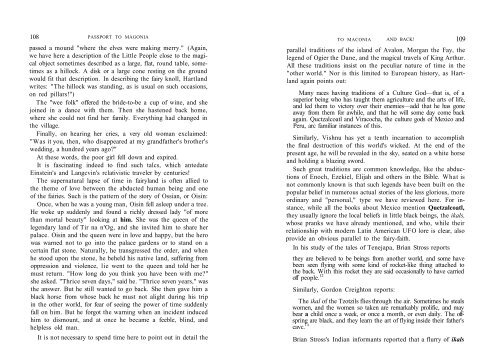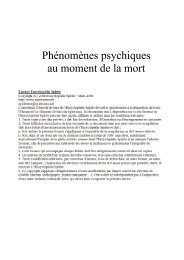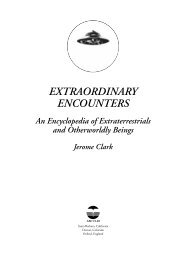You also want an ePaper? Increase the reach of your titles
YUMPU automatically turns print PDFs into web optimized ePapers that Google loves.
108 PASSPORT TO MAGONIA<br />
passed a mound "where the elves were making merry." (Again,<br />
we have here a description of the Little People close to the magical<br />
object sometimes described as a large, flat, round table, sometimes<br />
as a hillock. A disk or a large cone resting on the ground<br />
would fit that description. In describing the fairy knoll, Hartland<br />
writes: "The hillock was standing, as is usual on such occasions,<br />
on red pillars!")<br />
The "wee folk" offered the bride-to-be a cup of wine, and she<br />
joined in a dance with them. Then she hastened back home,<br />
where she could not find her family. Everything had changed in<br />
the village.<br />
Finally, on hearing her cries, a very old woman exclaimed:<br />
"Was it you, then, who disappeared at my grandfather's brother's<br />
wedding, a hundred years ago?"<br />
At these words, the poor girl fell down and expired.<br />
It is fascinating indeed to find such talcs, which antedate<br />
Einstein's and Langcvin's rclativistic traveler by centuries!<br />
The supernatural lapse of time in fairyland is often allied to<br />
the theme of love between the abducted human being and one<br />
of the fairies. Such is the pattern of the story of Ossian, or Oisin:<br />
Once, when he was a young man, Oisin fell asleep under a tree.<br />
He woke up suddenly and found a richly dressed lady "of more<br />
than mortal beauty" looking at him. She was the queen of the<br />
legendary land of Tir na n'Og, and she invited him to share her<br />
palace. Oisin and the queen were in love and happy, but the hero<br />
was warned not to go into the palace gardens or to stand on a<br />
certain flat stone. Naturally, he transgressed the order, and when<br />
he stood upon the stone, he beheld his native land, suffering from<br />
oppression and violence, lie went to the queen and told her he<br />
must return. "How long do you think you have been with me?"<br />
she asked. "Thrice seven days," said he. "Thrice seven years," was<br />
the answer. But he still wanted to go back. She then gave him a<br />
black horse from whose back he must not alight during his trip<br />
in the other world, for fear of seeing the power of time suddenly<br />
fall on him. But he forgot the warning when an incident induced<br />
him to dismount, and at once he became a feeble, blind, and<br />
helpless old man.<br />
It is not necessary to spend time here to point out in detail the<br />
TO MACONIA AND BACK! 109<br />
parallel traditions of the island of Avalon, Morgan the Fay, the<br />
legend of Ogier the Dane, and the magical travels of King Arthur.<br />
All these traditions insist on the peculiar nature of time in the<br />
"other world." Nor is this limited to European history, as Hartland<br />
again points out:<br />
Many races having traditions of a Culture God—that is, of a<br />
superior being who has taught them agriculture and the arts of life,<br />
and led them to victory over their enemies—add that he has gone<br />
away from them for awhile, and that he will some day come back<br />
again. Quctzalcoatl and Viracocha, the culture gods of Mexico and<br />
Peru, arc familiar instances of this.<br />
Similarly, Vishnu has yet a tenth incarnation to accomplish<br />
the final destruction of this world's wicked. At the end of the<br />
present age, he will be revealed in the sky, seated on a white horse<br />
and holding a blazing sword.<br />
Such great traditions are common knowledge, like the abductions<br />
of Enoch, Ezekiel, Elijah and others in the Bible. What is<br />
not commonly known is that such legends have been built on the<br />
popular belief in numerous actual stories of the less glorious, more<br />
ordinary and "personal," type we have reviewed here. For instance,<br />
while all the books about Mexico mention Quetzalcoatl,<br />
they usually ignore the local beliefs in little black beings, the ikals,<br />
whose pranks we have already mentioned, and who, while their<br />
relationship with modern Latin American UFO lore is clear, also<br />
provide an obvious parallel to the fairy-faith.<br />
In his study of the tales of Tenejapa, Brian Stross reports<br />
they are believed to be beings from another world, and some have<br />
been seen flying with some kind of rocket-like thing attached to<br />
the back. With this rocket they are said occasionally to have carried<br />
off people. 12<br />
Similarly, Gordon Creighton reports:<br />
The ikal of the Tzotzils flies through the air. Sometimes he steals<br />
women, and the women so taken are remarkably prolific, and may<br />
bear a child once a week, or once a month, or even daily. The offspring<br />
are black, and they learn the art of flying inside their father's<br />
cavc. 1:i<br />
Brian Stross's Indian informants reported that a flurry of ikals





